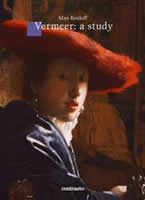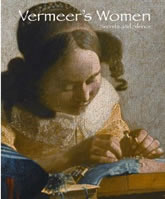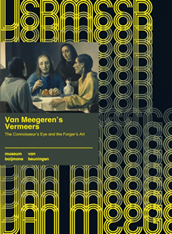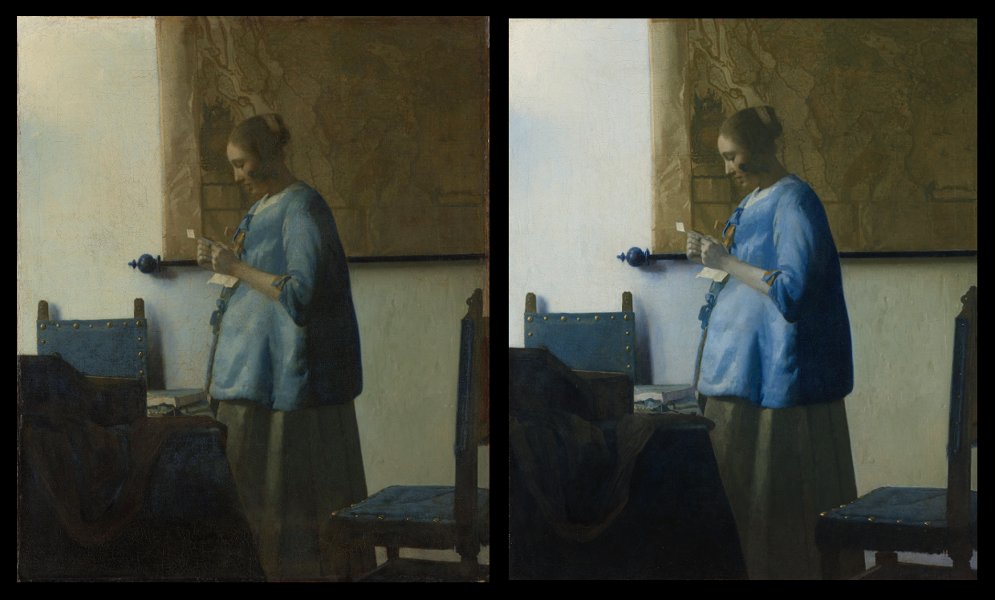Dear Subscriber,
I hope this email finds you well and that your summer was more reinvigorating than mine. But since I spent the last months in Roman heat maneuvering fine-tip brushes, inhaling turpentine fumes and trying to deal with erratic paint mediums, I feel entitled to break away for a week and take advantage of the ongoing diaspora of Vermeer paintings.
The upcoming Vermeer's Women: Secrets and Silence exhibition in Cambridge looks like the perfect event to provide moral solace, fresh air and perhaps, the chance to ask directly Vermeer a few questions. For example, the recently reattributed A Young Woman Seated at the Virginals (New York private collection) can be compared at close quarters to her more elaborate London counterpart, A Lady Seated at a Virginal. Except for a very few brave souls, members of the art history community have taken the cautious route and abstained from pronouncing themselves as to the authenticity of the tiny New York piece.
I'll be in Cambridge for the press presentation on October 4th, will dig in better the 5th to do some prolonged picture looking and thereafter a few days in London to do what you would reasonably expect a devotee of Vermeer and Dutch painting to do.
Don't hesitate to let me know if you think our roads might cross in front of or near some fine painting.
Best of all,
Jonathan Janson
Click here to access this newsletter as a WORD Document

Vermeer's Women: Secrets and Silence
October 5, 2011–January 15, 2012
The Fitzwilliam Museum, Cambridge, England
At the heart of this visually stunning exhibition is Vermeer's extraordinary painting The Lacemaker, one of the Musée du Louvre's most famous works, rarely seen outside Paris and now on loan to the UK for the first time. The painting will be joined by a choice selection of other key works by Vermeer representing the pinnacle of his mature career, and over thirty other masterpieces of genre painting from the Dutch "Golden Age." Featuring works from museums and private collections in the UK, Europe and the USA.
The four Vermeer's present in the exhibition are, The Lacemaker, Lady Seated at a Virginals, the extraordinary and rarely exhibited The Music Lesson as well as A Young Woman Seated at the Virginal.
The exhibition presents a truly unique opportunity to compare side-by-side the recently reattributed A Young Woman Seated at the Virginal (from a private New York collection) with the larger and more elaborate counterpart Lady Seated at a Virginals (from the London National Gallery). Vermeer enthusiasts might be aware that recent specialist studies reveal that the canvas of the New York A Young Woman Seated at the Virginal was cut from the same bolt of canvas used for The Lacemaker, a fact which has, in some critics' eyes, strengthened the authenticity of the New York work.
Also present is a curious and rare Dutch works by Dutch painter such as Jacobus Vrel, whose stark interiors have been directly associated with Vermeer's, as well as exquisite interiors by Gerrit ter Borch and Gerrit Dou.

Vermeer: A Study
by Max Kozloff
In the visual history of the western world, some images and authors have become real icons for entire generations of painters, photographers and common people. How could they remain so vivid in our memory, defeating oblivion? What was their secret? In this essay, Max Kozloff talks about one of the most emblematic and fascinating artists of our visual tradition, Vermeer, about his XVII century Dutch interiors, plunged into a palpable and magic light and about his ability to create refined images and atmospheres that are still able to move and seduce contemporary society. In this book, the author attempts to decipher the symbols hiding in Vermeer's paintings and to find out the secret thanks to which his works have managed to remain so popular and appreciated even nowadays.

Vermeer's Women: Secrets and Silence
by Marjorie E. Wieseman, Wayne Franits, H. Perry Chapman
Yale University Press- November 22, 2011
Focusing on the extraordinary Lacemaker from the Musée du Louvre, this beautiful book investigates the subtle and enigmatic paintings by Johannes Vermeer that celebrate the intimacy of the Dutch household. Moments frozen in paint that reveal young women sewing, reading or playing musical instruments, captured in Vermeer's uniquely luminous style, recreate a silent and often mysterious domestic realm, closed to the outside world, and inhabited almost exclusively by women and children.
Three internationally recognized experts in the field explain why women engaged in mundane domestic tasks, or in pleasurable pastimes such as music making, writing letters, or adjusting their toilette, comprise some of the most popular Dutch paintings of the seventeenth century. Among the most intriguing of these compositions are those that consciously avoid any engagement with the viewer. Rather than acknowledging our presence, figures avert their gazes or turn their backs upon us; they stare moodily into space or focus intently on the activities at hand. In viewing these paintings, we have the impression that we have stumbled upon a private world kept hidden from casual regard.

Human Connections in the Age of Vermeer
Arthur, Jr. K. Wheelock and Danielle H.A.C. Lokin
Scala Publishers - October 16, 2011
This catalogue focuses on the many forms of communication that existed in seventeenth-century Dutch society between family members, lovers and professional acquaintances, both present and absent. The forty-four carefully selected Dutch genre paintings include major works by many of the finest masters of the period, including Johannes Vermeer, Pieter de Hooch, Gerrit ter Borch and Gabriel Metsu. Vermeer's three masterpieces about love letters form the core of the exhibition as they are profound examples of the power of communication.
Complete book on Vermeer of Delft & the seventeenth-century city of Delft
Drs. Kees Kaldenbach
publishing date to be announced
http://kalden.home.xs4all.nl/verm/vermeerbook0.html
from the author's website:
This book sets out to tell the story of the relationship between Vermeer and Delft. After some 350 years, Vermeer the man and artist is mainly known to us through two prime sources: his paintings and a great number of archival documents. These documents are peripheral. As there are no letters, diaries or other personal documents, we really have very little to go on regarding his artistic, professional and private life. Only a few lines in diaries and letters written by contemporaries mention the name Vermeer. His private life seems thus to have faded away into the mists of time. However, one area of his life is still fairly clear to us: his network of financial dealings, solidly tying Vermeer to his townspeople and in the fabric of Delft economic life. For the past decades, Vermeer has been the object of detailed historical and archival studies and as a result we may now make valid statements and assumptions. The combined sources of all of his paintings and documents allow us to understand and explore Vermeer as a man and artist within the fabric of Delft.
An essay on Vermeer, brain channels, neural stimulus, visual perception and art appreciation.
Drs. Kees Kaldenbach, Amsterdam.
publishing date to be announced
http://kalden.home.xs4all.nl/verm/vermeerperception1.html
from the author's website:
During the past decades many cognoscenti (cognoscenti think they are in the know) have come to realize that Vermeer has surpassed Rembrandt as the crowning glory of Seventeenth Centaury Dutch art. Many books have been written about the fabulous magic and allure of Vermeers paintings. I think that cognitive science, brain channels, neural stimulus, visual perception, neuroscience and neuresthetics have many things to say and explain about why and how. This text is a tribute to Hale, Ramachandran and many other authors with a good eye and an open mind.
Van Meegeren's Vermeers. The Connoisseur's Eye and the Forger's Art
by Friso Lammertse, Nadja Garthoff, Michel van de Laar and Arie Wallert
(available via https://amzn.to/4gSQ2Me from Amazon.com

From the museum's press release:
New facts have emerged about the greatest forgery of the twentieth century: the 'Vermeers' of master forger Han van Meegeren. Museum Boijmans Van Beuningen owns possibly the most famous forgery in the Netherlands: The Supper at Emmaus. The latest in the series of publications, Boijmans Studies, deals with the history of this sensational forgery and reveals how Van Meegeren was able to mislead the entire art world.
Until now it was believed that Han van Meegeren (1889–1947) used pigments that were common in the seventeenth century. But recent analysis of the forged painting shows that Van Meegeren's paint also contained pigments that were not introduced until the nineteenth century. It has also emerged that there were indeed concerns about the authenticity of the 'Vermeers' at the time. The diary of Willy Auping (then curator at the Kröller-Müller Museum) has recently come to light. In it he writes disparagingly of The Washing of the Feet by 'Vermeer', purchased by the Rijksmuseum at the time for the extraordinarily high sum of 1.3 million guilders: 'Everything is just bad and crude and I really don't know what I can say about it, but it is absurd to believe for one moment that the great Johannes Vermeer of Delft could ever have made such a bad painting as this […]'.
Click here to access the high-resolution image
The Rijksmuseum has made available online an excellent height-resolution image of Vermeer's recently restored Woman in Blue Reading a Letter (the painting is currently in Japan on temporary loan).
Other than the overall greatly refreshed appearance, the most striking difference is the brilliant coloring of the woman's silk morning jacket which now appears to be much more intense than the upholstery coverings of the two lion's-head finial chairs alongside the figure. This difference gives the figure more volume and enhances the sense of three-dimensional depth of the pictured space.
Also to be noted are the appearance of a row of tiny brass nail-heads which run parallel along the shadowed side of the foreground chair. In the same foreground chair the form of the chair leg below the dark blue fringe is now square instead of the retouched roundish leg.
From what I can make out from the digital image, the curious, brownish scarf-like object which meanders in the deep shadow and hangs off the foreground edge of the table has acquired material substance which had completely lacked before the restoration. If I am not mistaken, this curious object most likely is the same one that gracefully drapes off the table in The Art of Painting and over the foreground chair in the late Love Letter. My fantasy has always brought me to believe that the same scarf constitutes the hanging part of the turban in the iconic Girl with the Pearl Earring.
Minor retouches which had altered some of the map's topography have been removed.
I have been informed that when the painting returns next year to Amsterdam, it will be presented to the public along with a special publication.
What does Whitey Bulger know about the 1990 Gardner Museum art heist?
Culture Monster: All the Arts, All the Time
June 23, 2011
http://latimesblogs.latimes.com/culturemonster/2011/06/what-does-whitey-bulger-know-about-the-1990-gardner-museum-art-heist.html
drawn from Culture Monster:
In 1990, two men dressed as police officers broke into the Isabella Stewart Gardner Museum in Boston and stole a Vermeer (The Concert), five Degas and three Rembrandts. The masterpieces and four other paintings stolen that day are estimated to be worth more than $500 million. Two decades later, the case remains stubbornly unsolved. It has been called "the holy grail of art crime."
Rumors have long swirled that Bulger, the head of the city's powerful Irish American mob at the time, may have played a role—or must have known who did.
Some have speculated that he stashed the stolen masterpieces away to use as a "get out of jail free card" if he was ever caught. Others think he sent the paintings to allies in the Irish Republican Army to use as a bargaining chip.
Although Ulrich Boser, author of The Gardner Heist: The True Story of the World's Largest Unsolved Art Theft, believes that
"To organize something like the Gardner heist doesn't make sense," Boser and others familiar with the case believe that Bulger may still have important information to contribute. Little happened in Boston in those days without Bulger knowing about it.
"If he was interested, he could have found out what was going on," said Robert Wittman, the former head of the FBI's art squad who helped investigate the Gardner theft. "I think there's a good chance he knows something."
EssentialVermeer.com and Facebook: A Progress Report
http://www.facebook.com/pages/Essential-Vermeer/133691276693957
What does the global social network Facebook have to do with Vermeer? At first glance very little. Take a look at many of the art institutions' Facebook pages that tend to be one-way monologues with insignificant interaction with the public. People's comments, it seems, really don't seem to matte.
I have been online with Facebook since January 15, 2011. Here's my experience so far.
The upside is that I have had some very stimulating (telegraphic) back-and-forths with people from all walks. Painters take the lion's share in the mini-debates as would be expected given that Vermeer has always been a quintessential "painters' painter." A few conservators and art historians occasionally weigh in with tips and observations. In order to keep the ball rolling one has to post at least once every two days. I have found it very useful to pose issues which a currently occupy my own studies (Vermeer's composition in particular) since on more than one occasion, the feedback was quite helpful and had me rethinking.
A Personal Message from Jonathan Janson: Essential Vermeer Funding 2011
Hi,
Ten years of communication with the public and art specialists has convinced me that our vision of Vermeer and Dutch painting will be increasingly shaped by what we will read and what we will write about them on the World Wide Web. The internet medium provides extraordinary means for the art history community which has only just begun to be tapped.
I am personally committed to making Essential Vermeer the most forward-looking art history website on the net, the website that Vermeer deserves and the global art-loving community heeds
The Essential Vermeer will continue to grow and offer new ways to explore the complexities of Vermeer's art and the art of his time. And it will continue to be free.
But in order to materially implement the highest quality expansion, new tools are required. I need to update my hardware, acquire more flexible software, research material and pay for the costs of technical collaboration, hosting, communication and travel.
If you share my goal of making Essential Vermeer the one of the most important art resources on the net, please feel free to make a contribution. It will be greatly appreciated.
Thanks,
Jonathan Janson
To know more about the goals of the Essential Vermeer website, please click on the link below.
WORD Document: Goals & Philosophy of Essential Vermeer

It is not necessary to register with PayPal to make credit card donations.
